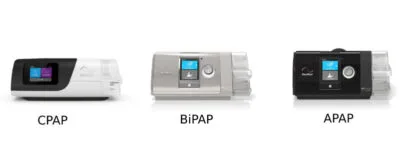
Quick Look: Types of CPAP devices and How They Work
One of the most revolutionary advancements in the treatment of obstructive sleep apnea involves the multiple benefits associated with a continuous positive airway pressure (CPAP) machine.
These devices provide a source of pressurized air during sleep, dramatically reducing many of the symptoms attributed to OSA – and ensuring restorative sleep, night after night.
While the principles behind CPAP are generally the same, there are actually a handful of unique variants to consider.
Each of these offers a host of unique benefits — and depending on your specific symptoms, some may be more appropriate than others. Let us examine the primary features of each type.
Traditional CPAP devices
This is the most common type of positive airway pressure machine. The main takeaway point here is that a typical CPAP will provide air that is pressurized at a constant rate. This air is then transported to the nose and mouth via a flexible tube and a facemask.
Standard CPAP devices still come in a host of unique configurations.
For example, some are nearly silent while operating. Others can include an internal heating element or a humidifier. These are often preferred by individuals who would otherwise suffer from a dry mouth and/or throat while sleeping.
Due to the sheer number of traditional CPAP devices, these also tend to represent the most cost-effective solutions (an obvious concern for anyone who needs to adhere to a tight budget).
BiPAP Variants
Another type of CPAP is often referred to as a BiPAP. BiPAP is an acronym for “bi-level positive airflow pressure”. Users are provided with two different pressure settings. One is associated with inhaling and the other setting will adjust the pressure when an individual exhales.
There are several scenarios when a BiPAP machine could represent a useful alternative. Some physicians recommend BiPAP units to patients with higher levels of carbon dioxide within their bloodstream (a BiPAP can regulate the blood gasses in the body enabling the work of breathing to be much easier). Sometimes patients require supplemental oxygen to be prescribed and bled into the mask for conditions such as COPD.
People who have been diagnosed with central sleep apnoea may also benefit from a BiPAP, as the main issue with this condition is the inability to initiate the breathing process while asleep.
Some BiPAPs have therefore been outfitted with a backup mechanism that governs the respiratory rate of the user during the overnight hours. These devices have a spontaneous timed (S/T) setting to regulate the back-up respiratory rate thus kicking a breath in when necessary.
Auto Servo Ventilators (ASV) are now quite popular because they auto regulate the back up rate making these forms of non-invasive ventilation devices very useful.
There may also be instances when a BiPAP is simply more comfortable than a traditional CPAP machine. Anyone who is not satisfied with their current CPAP therapy should therefore speak with a sleep specialist to determine if a BiPAP is a viable alternative.
BIPAPs are often prescribed when the fixed CPAP pressure is high somewhere between 10 and 20 cm H20. By providing a lower expiratory pressure, this makes it easier to breath against a high oncoming constant CPAP pressure.
APAP Devices
These are among the most advanced on the market. APAP stands for “automatic positive airflow pressure” and these devices function as the name suggests. An APAP will constantly monitor breathing patterns and snoring throughout the night. Pressures can therefore be slightly changed automatically in accordance with the user’s disordered breathing.
One interesting benefit associated with this device is that it provides virtually hands-off operation. APAPs can also be used by those who are taking medication that could impact their breathing. Additionally, the machine will automatically adjust pressure levels due to changes in sleeping positions.
A final advantage of an APAP involves the fact that these devices always attempt to use the lowest possible pressure level required.. This is beneficial for those who develop sensations of claustrophobia due to high pressures.
During REM sleep, higher pressures are required and an APAP is more comfortable because this occurs only 20% of the night. The other 80% of the night the body is in Non REM sleep that requires lower pressures and is much easier to breath against.
APAPs have been on the market for over ten years and are now priced similarly to fixed pressure CPAPs.Some companies, like SleepQuest, only provide APAP devices since they can also be set to a fixed CPAP pressure if required. If the pressures need to be changed they can be done so remotely with a valid prescription from your doctor.
Portable Travel CPAP Devices
As the technology associated with CPAP continues to advance at a breakneck pace, many of their components have become much smaller when compared to older models. This has led to some designs being suitable for travel purposes.
Portable CPAP devices are lightweight.They might even come with the option of installing a modular humidifier. However, we should note that the majority of portable units are not yet capable of BiPAP functionality. Making the Right Choice
Which one of these options is the most appropriate for your needs? Answering this question will need to take into account several factors such as:
- The severity of your sleep apnea symptoms.
- Whether or not you are satisfied with your current CPAP.
- If you suffer from dry mouth or nasal congestion while asleep.
- Your budget (BiPAP, BIPAP S/T and ASV devices can be somewhat expensive).
Either way, the chances are high that at least one of these configurations will provide the results that you have been looking for.
Whether you have recently been diagnosed with obstructive sleep apnea or you hope to upgrade your current machine, it is always a good idea to consult with your physician or a sleep specialist.
Sources:
https://thesleepdoctor.com/cpap/types-of-cpap-machines/
https://www.healthline.com/health/what-is-a-cpap-machine
https://my.clevelandclinic.org/health/treatments/22043-cpap-machine



